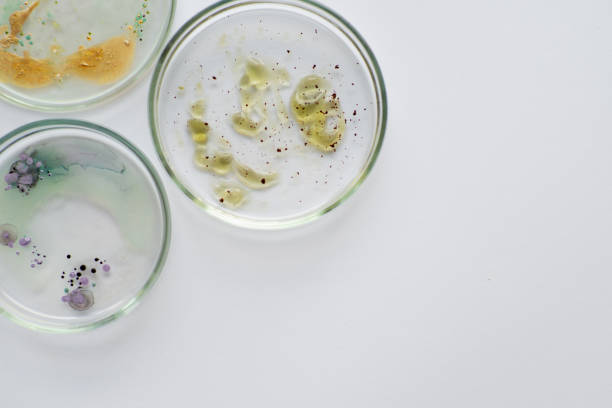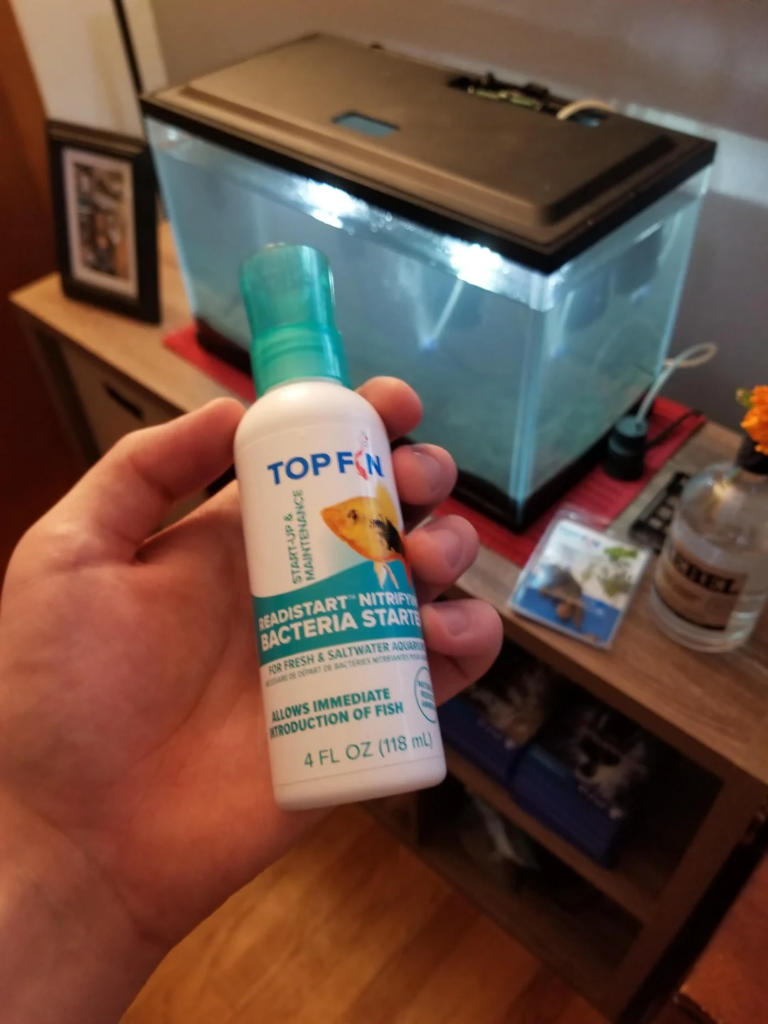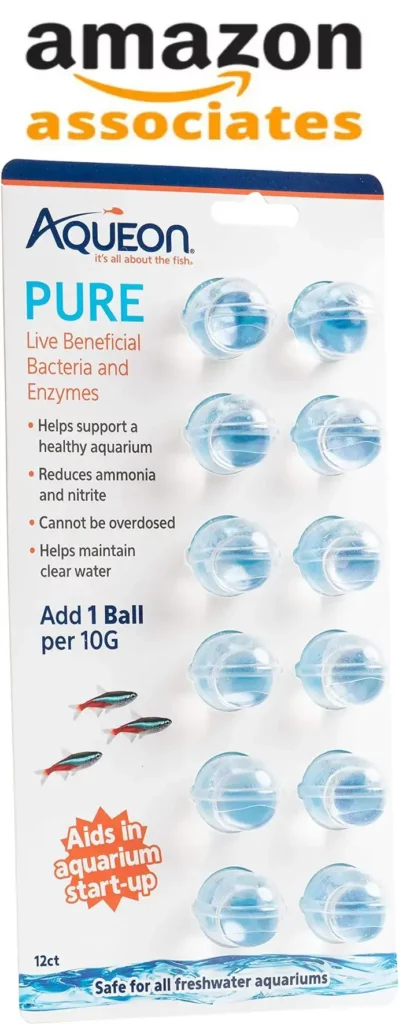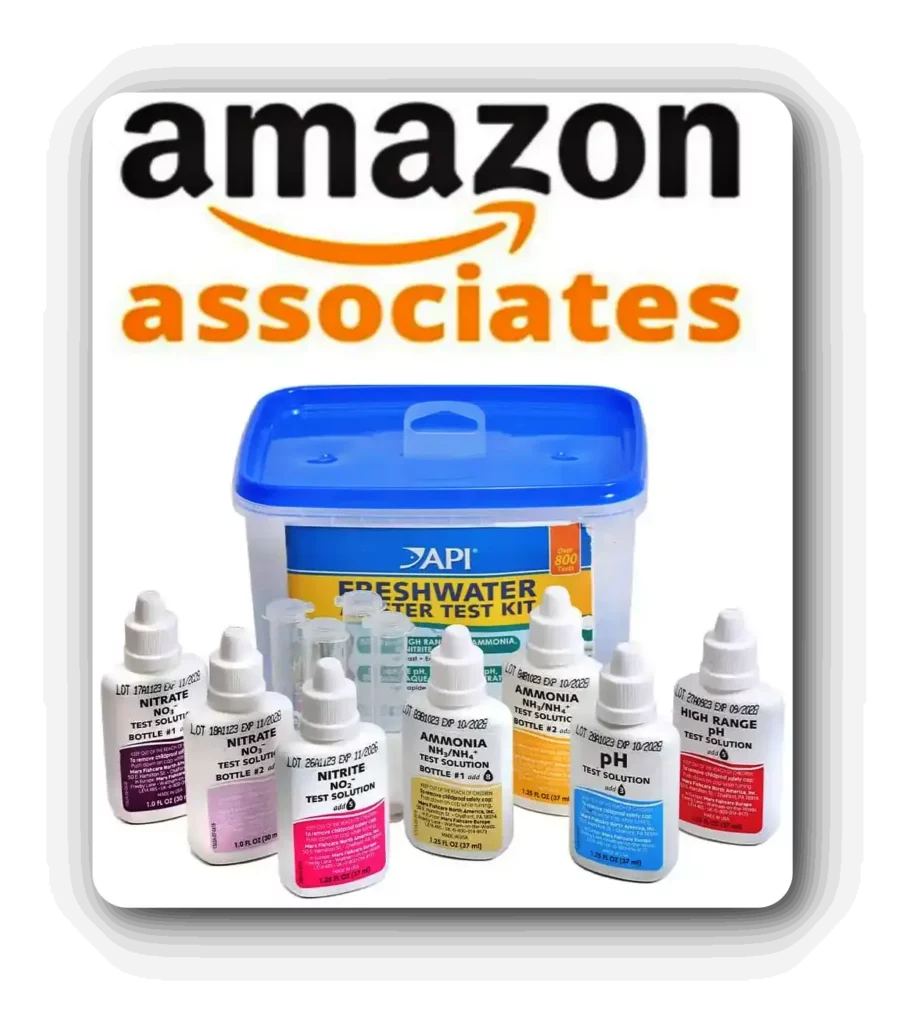Speed up the nitrogen cycle in your aquarium using fish tank bacteria starters. Choose the best bacteria starter for a healthy fish and aquarium ecosystem.

Maintaining a thriving aquarium is about creating a balanced ecosystem where aquatic life can flourish. One way to do this is by introducing a fish tank bacteria starter.
This beneficial bacteria creates a sustainable environment within the aquarium. During tank cycling, it kickstarts the nitrogen cycle by breaking down ammonia into nitrite and nitrate.
This article teaches you how to use your aquarium bacteria starter, its importance, choosing a type, common mistakes, and how to avoid them.
Whether you’re a seasoned aquarist or a beginner, following this guide for your new aquarium setup will improve your fish’s health.
What Is A Bacteria Starter?
A bacteria starter is a supplement added to a fish tank to kickstart the aquarium’s nitrogen cycle. It establishes beneficial bacteria that convert harmful ammonia and nitrite into safer compounds like nitrate.
The fish tank cycle process introduces aquarium bacteria to safeguard and create an enabling environment for the fish and marine life.
Why Use A Bacteria Starter?
There are several benefits of bacteria starter in aquariums, including faster tank cycling, improved fish health, reduced nitrite and ammonia, and overall aquarium health.
Faster Tank Cycling
Bacteria starters accelerate the nitrogen cycle, allowing the tank to mature faster and quickly, making it habitable for your fish.
Healthier Fish
Bacteria starters help produce healthy fish by boosting the aquarium’s ecosystem. This reduces stress and disease risk by eliminating toxins.
Reduced Ammonia and Nitrite Levels
Bacteria starters achieve nitrite and ammonia reduction by breaking them into safer compounds and reducing the risk of toxic poisoning for your fish.
Improved Waste Management
Use a robust biological filter to break down organic waste and reduce the risk of water quality issues.
Bacteria starters establish a healthy nitrogen cycle and enhance overall water quality and biological filtration capacity, generally improving aquarium health.
Types of Bacteria Starters

If you’ve scouted the market shelves for a bacteria starter, you’ll know there are different types and textures. These differences can get confusing for new fishkeepers, but that’s why I’m here. I’ll break down each type and a few other aquarium bacteria products.
The types of bacteria starters come in Powder, Liquid, or Gel form. Here’s what to expect from each one.
Here are The 5 Best Aquarium Bacteria Supplements & Starters we have reviewed.
Powder Bacteria Starter
The powder bacteria starter is the most convenient and popular form. Depending on the brand, you can mix it into a paste with liquid or use it in its dry form.
Before using the powder bacteria starter, its properties are latent until it mixes with a reagent, especially if it’s for mixing.
Buy this type of bacteria starter if you’re on a budget. The good thing is that it’s versatile; you can use it for freshwater and saltwater aquariums.
Liquid Bacteria Starter
Unlike the powder form, which needs a reagent, the liquid bacteria starter is already activated and cultured. Because of its liquid form, this type of bacteria starter is perfect for large-scale use. A little drop will spread wider than you can imagine!
The active bacteria in the liquid make it ready to use, but it also has a short lifespan.
Gel Bacteria Starter
Can you imagine a bacteria starter made into a gel capsule? Because it exists. Like the liquid form, the gel bacteria starter is also great for fermentation. However, the thicker consistency makes it better for slow and concentrated usage.
Unfortunately, gel bacteria starters don’t last as long as the powder forms because of their active bacteria.
Other aquarium products include Freeze-dried bacteria starters, a blend of dry and liquid forms, beneficial bacteria supplements, biofilters, substrate additives, and denitrifying bacteria.
How To Choose The Right Bacteria Starter
Choosing a bacteria starter requires careful consideration and proper planning. It also depends on certain features, like the types of aquarium waters, the fish species you breed, and other living organisms in the tank. Let’s examine each factor.
Aquarium Type
Is your aquarium filled with freshwater or saltwater? Freshwater aquariums need a freshwater bacteria starter, while saltwater aquariums are compatible with a saltwater bacteria starter.
That’s the general rule, but there are always a few exceptions. Sometimes, brands label their bacteria starters as ideal for both water types, but they’re not wrong. But you’ll notice that the products work better in one kind of water than the other.
That’s because, like fish and other living organisms that have natural habitats, bacteria also do. So, freshwater bacteria will struggle to survive in salt water, and if they can’t live long enough to do their job, what’s the point?
Fish Type
Yes, there are fish-specific bacteria starters like water-specific bacteria starters. General-purpose starters are ideal for freshwater fish, but there’s more. You’ll need a fish-specific bacteria starter when treating certain species.
A prime example is the catfish, which lives at the bottom of the sea. Because it lives in the substrate, only bacteria starters for substrates can adequately break down its waste.
Meanwhile, you’ll need a saline bacteria starter to break down saltwater fish waste.
Product Type
Some bacteria starters are niche products. They could be cycling a new tank or starting a culture in an old tank.
Highly concentrated products make the best bacteria starters for cycling new aquariums because they speed up the nitrogen cycle and stabilize the biological filter.
So, how can you use your bacteria starter?
How To Use A Bacteria Starter

Using a bacteria starter is an easy activity that needs no professional help! But you need to follow some instructions, like learning how to add bacteria starter in the correct quantity.
Consider this a fish tank bacteria guide for any aquarium setup.
Here’s a step-by-step guide on how to use a bacteria starter:
For Liquid Bacteria Starters
- Shake the bottle well before use to ensure the contents mix well.
- Measure the recommended dose according to the product instructions, usually on the bottle.
- Add the liquid bacteria starter directly to the aquarium water. Concentrate your application on the areas where beneficial bacteria colonize, such as the filter or substrate.
For Powder Bacteria Starters
- Measure the recommended dose according to the product instructions on the body of the product.
- Mix the powder with a small amount of water to create a paste. Depending on the product, an additional liquid reagent may also be needed.
- Add the paste to the aquarium water, targeting areas where beneficial bacteria colonize, such as the filter or substrate.
For Gel Bacteria Starters
- Follow the product instructions for the recommended dose, which is on the body, on the label, or in the instruction manual.
- Release the gel bacteria starter into the aquarium water.
Typically, the dosage for use of bacteria starters is on the product. But here are some valuable tips that you should remember as general rules:
- Depending on the size of your aquarium, the initial dose of a bacteria starter is typically higher than subsequent doses.
- After the initial dose, top up the bacteria starter by adding smaller doses to the aquarium.
- Test water regularly for toxins such as ammonia, nitrite, and nitrate to ensure the bacteria starter is cycling the tank effectively.
- The dosage and frequency of adding an aquarium bacteria starter will depend on the specific product used, so it’s essential to carefully read and follow the instructions provided by the manufacturer.
Common Mistakes To Avoid

Now that you know all about bacteria starters, it’s time to take precautions. It’s easy to get overexcited and misuse the product. But I’ve made enough bacteria starter mistakes when starting that you don’t have to suffer the same fate.
Here are some common aquarium mistakes when using your bacteria starter and how to avoid them:
Improper Bacteria Starter Usage
Using too little bacteria starter leads to slow or incomplete cycling, and using the wrong type of bacteria starter may leave little to no effect.
Solution: Match the right bacteria starter to the correct aquarium. Also, study the different forms of bacteria starter texture and how to use them.
Incorrect Temperature
Bacteria starters are sensitive to temperature, so using them outside the recommended range (usually 22-28°C) can hinder their effect.
Solution: Monitor and maintain optimal water temperature using a coolant or heater. The aquarium temperature depends on the tank’s fish species and water type.
Inadequate Nutrient Supply
Bacteria need nutrients to grow and multiply. So, insufficient food sources, like ammonia or nitrite, will slow the cycling process.
Solution: Provide enough food that your fish can finish in a short time — 10 minutes or less. They’ll pass out the right amount of waste to start the nitrogen cycle.
Over-Medication
Medications or water treatments that harm or kill beneficial bacteria disrupt the cycling process.
Solution: Avoid using medications during the cycling process. Instead, remove sick fish from the tank and keep them isolated somewhere else while they recover.
Inadequate Tank Preparation
Not properly cleaning and preparing the tank and equipment can lead to the growth of harmful bacteria that’ll compete with the beneficial ones.
Solution: Clean your tank and air it out before adding water.
Remember that these are common aquarist mistakes, even for professionals and long-term fishkeepers. So, don’t beat yourself up if you make any of these tank cycling errors. Instead, be patient, unlearn, and relearn using this guide.
Monitoring Your Aquarium After Using a Bacteria Starter
Once you’ve introduced a bacteria starter to your tank, it’s time to focus on monitoring the aquarium. You can’t leave the beneficial bacteria and assume they’d do their job without you there to ensure the nitrogen cycle is going on properly.
Firstly, you must invest in post-bacterial starter care. Get test kits and equipment ideal for fish tank monitoring. It’ll tell you when ammonia and nitrite levels are changing. That way, you can determine if the cycle is slow, fast, or average.
Next, you can observe the aquarium water parameters from the acidity to the alkaline, hardiness, and oxygen. Adjust the parameters accordingly, and you can say you’ve completed a successful tank cycling process.
Alternative Methods to Introduce Beneficial Bacteria
You can try alternative bacteria introduction methods if you can’t access bacteria starters. Introducing beneficial bacteria methods can be natural, and here’s how to do them:
Using an Established Tank
When you use filter media from an established tank, you don’t need starters to speed up the nitrogen cycle. Transfer the filters, such as ceramic rings and sponges, to the new tank.
They’re already used to kickstarting the cycle, so it’ll be business as usual, just in a new home.
Adding Live Plants
Some plants have beneficial bacteria that naturally grow from them. If you put these live plants in your aquarium, they’ll maintain your water quality without trying.
Natural Tank Cycling
Relying on natural tank cycling is a healthy way to introduce beneficial bacteria. Mix your fish with other living organisms with beneficial bacteria in their digestive systems. So, when they pass waste, they automatically influence the cycle in the aquarium.
Now, to answer some F.A.Q.s.
u003cstrongu003eHow Long Does It Take For A Bacteria Starter To Work?u003c/strongu003e
There’s no standard bacteria starter timeframe, no matter what the label on a product says. The length depends on multiple factors ranging from the type of starter to the water condition, waste quantity, and ecosystem. u003cbru003eu003cbru003eIf you start your cycle by establishing a biological filter, it’ll be faster, while cycling a new tank takes longer. The average aquarium bacteria cycle time is from a few days (for starters or transferred filter media) to six or more weeks. u003cbru003eu003cbru003eThe tank cycling duration, however, doesn’t last longer than eight to twelve weeks. If it takes that long, then there’s a problem. Perhaps your aquarium is overcrowded. So, to answer your question, u003cemu003eu0022How long is it for a bacteria starter to work?u0022 u003c/emu003e u003cbru003eu003cbru003eIt takes a few days to spread the beneficial bacteria. It takes up to six weeks to complete a nitrogen cycle. It takes another few days for the beneficial bacteria to stabilize.
u003cstrongu003eCan You Add Too Much Bacteria Starter To A Fish Tank?u003c/strongu003e
Yes. There’s such a thing as u0022too much bacteria starter.u0022 Using more products than prescribed is okay until you use an excess amount. What happens after overdosing on your bacteria starter? You’ll cause an imbalance, which may become counterproductive. u003cbru003eu003cbru003eInstead of breaking down the ammonia levels, it’ll increase them and endanger the aquarium’s bacteria safety. That means your fish tank bacteria levels may become dangerously high and encourage more harmful bacteria than beneficial ones.u003cbru003eu003cbru003eStick to the prescribed bacteria starter dosage to avoid such a risky effect.
u003cstrongu003eIs A Bacteria Starter Necessary For Every New Tank?u003c/strongu003e
No. You can complete your fish tank cycling without a starter, but it’ll be slower. Add live plants, use established filter media, or biological organisms. Check out the u003ca href=u0022https://aquanswers.com/how-long-does-it-take-to-cycle-a-tank/u0022 target=u0022_blanku0022 data-type=u0022linku0022 data-id=u0022https://aquanswers.com/how-long-does-it-take-to-cycle-a-tank/u0022 rel=u0022noreferrer noopener nofollow sponsoredu0022u003ealternative way to add beneficial bacteria to an aquariumu003c/au003e besides using a bacteria starter. u003cbru003eu003cbru003eThe positive effects in this guide prove the necessity of using bacteria starters for cycling. You don’t need it for your new aquarium setup, but it’ll boost the bacteria activity of your new tank. u003cbru003eu003cbru003eUltimately, it’s optional to use a bacteria starter, depending on your preference.
Conclusion
It’s time to leave you to practice all you’ve learned in this guide. Before I go, let’s recap the importance of bacteria starters in fish tanks –
- It builds a healthy aquarium environment.
- It increases your fish’s lifespan.
Choosing a bacteria starter is a matter of preference and the uniqueness of your aquarium. What are your fish species, water type, and aquarium size? Once you answer these questions, start using your bacteria starter to speed up your nitrogen cycle.
And on that note, I say goodbye.
Please come back and share your experiences after using the tips in this guide.





